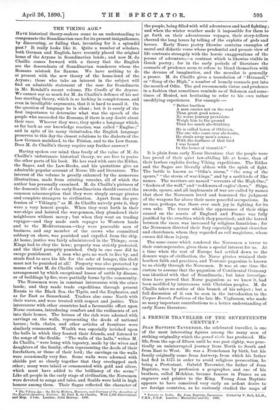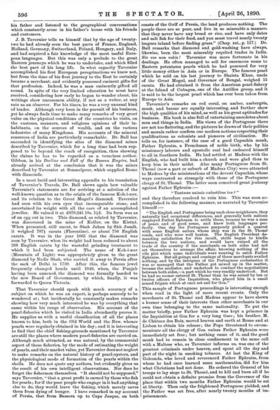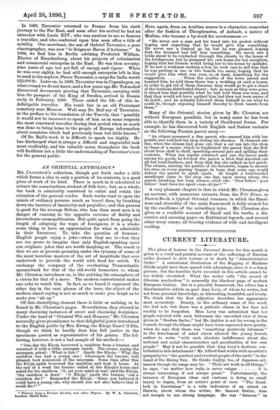A FRENCH TRAVELLER OF THE SEVENTEENTH CENTURY.*
JEAN BAPTISTE TAVERNIER, the celebrated traveller, is one of the most interesting figures among the many men of striking originality which the grand siecle has produced. His life, from the age of fifteen until he was past eighty, was prac- tically an uninterrupted journey from North to South and from East to West. He was a Frenchman by birth, but his family originally came from Antwerp, from which his father had fled in 1575 in order to avoid religious persecution, he being a Protestant. Gabriel Tavernier, the father of Jean Baptiste, was by profession a geographer, and one of his brothers, called Melchior, became famous in France as an engraver and printer to the King. Young Jean Baptiste appears to have conceived very early an ardent desire to see foreign countries, as he curiously studied the maps of • Travels in India. By Jean Baptiste Tavernier. Edited by V. Ball, LL.D., F.R.S., F.G.S. London : Macmillan and Co. 1889.
his father and listened to the geographical conversations which constantly arose in his father's house with his friends and customers.
J. B. Tavernier tells us himself that by the age of twenty- two he had already seen the best parts of France, England, Holland, Germany, Switzerland, Poland, Hungary, and Italy, and had acquired a fair knowledge of the most useful Euro- pean languages. But this was only a prelude to the great Eastern journeys which he was to undertake, and which filled the best part of his long life. In what capacity Tavernier accomplished his first European peregrinations we know not, but from the time of his first journey to the East he certainly became a merchant, and evidently possessed eminent gifts for that profession. Indeed, he was a man eminently gifted all round. In spite of the very limited education he must have .received, considering how early he began to wander about, his writings show uncommon ability, if not as a writer, at any rate as an observer. For his times, he was a very unusual kind of -trader. Although very keen in the pursuit of his business, „yet he always finds time to make many remarks of very great value on the physical conditions of the countries he visits, on the customs, manners, and religious opinions of their in- habitants, on the sources of wealth, and on the various industries of many Kingdoms. His accounts of the mineral resources of India are particularly remarkable. Dr. Ball has succeeded in identifying the sites of the diamond mines described by Tavernier, which for a long time had been sup- posed to be beyond the reach of recognition, thus showing the claims he has to be regarded as a veracious author. ]-ibbon, in his Decline and Fall of the Boman Empire, had already arrived at the conclusion that it was the mines described by Tavernier at Sonmelpour, which supplied Rome -with diamonds.
In a most lucid and interesting appendix to his translation of Tavernier's Travels, Dr. Ball shows again how valuable 'Tavernier's statements are for arriving at a solution of the well-known question as to the origin of the famous Koh-i-nur, and its relation to the Great Mogul's diamond. Tavernier had seen with his own eyes that incomparable stone, and ascertained its weight with all the care of an accomplished jeweller. He valued it at 2879,245 18s. 10. Its form was as of an egg cut in two. This diamond, as related by Tavernier, was discovered in the mine of Kollur, on the Kistnii. When presented, still uncut, to Shah Jahan by Shit Jumli, it weighed 787i carats (Florentine), or about 756 English carats. It was in the year 1665 that the diamond was seen by Tavernier, when its weight had been reduced to about '268 English carats by the wasteful grinding treatment to which it had been subjected. The name of Koh-i-nur (Mountain of Light) was appropriately given to the great diamond by Nadir Shah, who carried it away to Persia after the sack of Delhi in 1739. After this, the famous jewel frequently changed hands until 1849, when, the Punjab having been annexed, the diamond was formally handed to the new Board of Government, by which, finally, it was forwarded to Queen Victoria.
That Tavernier should speak with much accuracy of a subject on which he was an expert, is perhaps scarcely to be wondered at ; but incidentally he constantly makes remarks showing how very much interested he was by everything that came within his range of observation. His account of the pearl-fisheries which he visited in India abundantly proves it. He supplies us with a useful classification of all the places known to him, both in the Old World and the New, whence pearls were regularly obtained in his day; and it is interesting to find that the chief fishing-grounds mentioned by Tavernier are still the places where modern pearl-fisheries are carried on. Although much attracted, as was natural, by the commercial aspect of those fisheries, by the mode of estimating the weight of pearls, and their market value, yet Tavernier does not neglect to make remarks on the natural history of pearl-oysters, and the physiological mode of formation of the pearls within the shells. He does not quote any authors, but evidently gives us the result of his own intelligent -observations. Nor does he forget the fishermen themselves. "It should not be supposed," says Tavernier, "that a great profit is earned by those who fish for pearls; for if the poor people who engage in it had anything else to do, they would leave the fishing, which merely saves them from dying of hunger. I have remarked in my account of Persia, that from Bassora up to Cape Jasque, on both
coasts of the Gulf of Persia, the land produces nothing. The people there are so poor, and live in so miserable a manner, that they never have any bread or rice, and have only dates and salt fish for their food, and you must travel nearly twenty leagues inland before finding grass." (Chap. xxi., p. 117.) Dr. Ball remarks that diamond and gold-washing have always,
likewise, been the most miserably requited trades in India. Sic vos non vobis ! Tavernier was more fortunate in his dealings. He often managed to sell for enormous sums to
Eastern potentates pearls which he had procured for very little money either in Asia or in Europe. The famous pearl which he sold on his last journey to Shaista Khan, uncle of the Great Mogul, and Governor of Bengal, weighed 55 carats. He had obtained it from the American pearl-fishery at the Island of Cubagua, one of the Antilles group, and it is said to be the largest pearl which has ever been taken from Europe to Asia.
Tavernier's remarks on red coral, on amber, ambergris, musk, and bezoar are equally interesting, and further show the high qualities of his mind, as well as his great aptitudes for business. His book is also full of entertaining anecdotes about men and things in India. His views of the Portuguese there are not too flattering, and the pictures he draws of their politics and morals rather confirm our modern notions respecting their qualifications as colonists and pioneers of civilisation. He tells us, for instance, of the case of a good Capuchin monk, Father Ephraim, a Frenchman of noble birth, who by his missionary labours and apostolic zeal had endeared himself to all in Southern India. He had settled at Madras with the English, who had built him a church and were glad thus to keep him in their midst. Also many Portuguese from St. Thome (now a part or suburb of Madras City) were attracted to Madras by the ministrations of the devout Capuchin, whose ways contrasted so strangely with those of the Portuguese clergy of St. Thome. The latter soon conceived great jealousy against Father Ephraim :—
"Tantiene animis ccelestibus ins F"
and they therefore resolved to ruin him. This was soon ac- complished in the following manner, as narrated by Tavernier himself :—
" The English and Portuguese being such close neighbours, they naturally had occasional differences, and generally both nations employed Father Ephraim to settle these, because he was a man of peace and of good sense, and knew both languages per- fectly. One day the Portuguese purposely picked a quarrel with some English sailors whose ship was in the St. Thome roads, and who were well beaten. The English President de- manding satisfaction for this insult, strife began to kindle between the two nations, and would have ruined all the trade of the country if the merchants on both sides had not set themselves to arrange the affair, knowing nothing of the vile plot which some individuals were weaving to catch Father Ephraim. But all goings and comings of these merchants availed nothing, and by the intrigues of the Portuguese ecclesiastics it was so managed that the Father got mixed up in the matter, became the mediator, and undertook to conduct the negotiations between both sides,—a part which he very readily undertook. But he had no sooner entered St. Thome than be was seized by ten or twelve officers of the Inquisition, who placed him in a small armed frigate which at once set sail for Goa."
This sample of Portuguese proceedings is interesting enough when read in the light of more recent events. Only the merchants of St. Thome and Madras appear to have shown a keener sense of their interests than other merchants in our own time belonging to the same nationality. To put the matter briefly, poor Father Ephraim was kept a prisoner in the Inquisition at Goa. for a very long time ; his brother, M.
de Chateau des Bois, moved heaven and earth at Rome and at Lisbon to obtain his release ; the Pope threatened to excom- municate all the clergy of Goa unless Father Ephraim were immediately set free ; but nothing came of it, and the good monk had to remain in close confinement in the same cell with a Maltese who, as Tavernier informs us, was one of the greatest criminals under heaven, and spent all the day and part of the night in smoking tobacco. At last the King of Golconda, who loved and reverenced Father Ephraim, from whom he had once learned some mathematics, did for him what Christians had not done. He ordered the General of his troops to lay siege to St. Thome, and to kill and bum all if he could not obtain a definite promise from the Governor of the place that within two months Father Ephraim would be set at liberty. Then only the frightened Portuguese yielded, and the Father was set free, after nearly twenty months of im- In 1668, Tavernier returned to France from his sixth journey to the Far East, and soon after his arrival he had an interview with Louis %W., who was anxious to see so famous a traveller, and who conferred upon him soon after a title of nobility. Our merchant, the son of Gabriel Tavernier, a poor nhartographer, was now "le Seigneur Baron d'Aubonne." In 1684, we find him in Berlin advising Frederick William, Elector of Brandenburg, about his projects of colonisation and commercial enterprise in the East. He was then seventy- nine years of age, but yet full of energy and vigour. When he was over eighty, he had still enough enterprise left in him to send to his nephew, Pierre Tavernier, a cargo for India worth 222,000 fr. Later on, in 1688, Tavernier was in Copenhagen, on what errand we do not know, and a few years ago Mr. Tokmakof discovered documents proving that Tavernier, carrying with him the passport of the King of Sweden, arrived in Russia early in February, 1689. There ended the life of this in- defatigable traveller. His tomb lies in an old Protestant cemetery near Moscow. Well may Dr. Ball say of Tavernier, in the preface to his translation of the Travels, that "possibly it would not be incorrect to speak of him as in some respects the most renowned traveller during that period when so much was done to bring home to the people of Europe information about countries which had previously been but little known."
Of Dr. Ball's work it is difficult to speak too highly. He has discharged what is always a difficult and ungrateful task most creditably, and his valuable notes throughout the book will facilitate not a little the understanding of Tavernier's text for the general public.




































 Previous page
Previous page